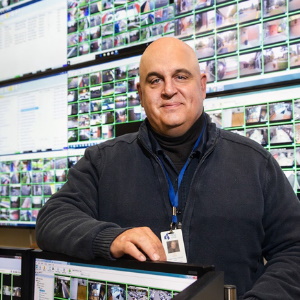
Holistic Security Solutions
in K12 Schools
Written by: Inovonics with industry expert insights from Guy Grace

Guy Grace's adoption of a holistic approach to school security came as the result of a tragedy in 2013.
It's not as if Grace was new to the world of school security. He’s one of the leading experts on the subject. Grace is the director of security and emergency planning for Littleton Public Schools, the chairman of the Partner Alliance for Safer Schools (PASS), which brings together expertise from the education community, law enforcement and the security industry to provide best practices for securing school facilities, and the recipient of numerous national security industry awards and recognitions.
It was a life-changing event for Grace. The student was already on his security team’s radar. They had even performed a threat assessment on him. In fact, they are one of the only schools that ever performed a threat assessment on a person who ended up committing a school shooting.
The problem is that at the end of the day, a threat assessment is only a piece of paper.
This was the beginning of the shift in Grace's approach to school security. As he says, “You can have all the armed responders you want, but it doesn't mean anything to active shooters. I'm an armed responder myself, but active shooters just don't care anymore that there's people like me at the schools. And no matter how quickly we stop a shooter at the school, it's always too late. It's still a tragedy.”
The Arapahoe High School shooting speaks to Grace's point. The active shooter was stopped in 80 seconds by an armed school resource officer, but not before a student had already been shot, and would later die.
The lesson from the Arapahoe High School tragedy was simple: The only way for Guy Grace to protect his schools would be to find a way to prevent the tragedies before they happened.
In Grace’s words, “There has to be a holistic balance. Each school is a community, and if our security approach is out of balance, then we can mitigate the threats, but we can never stop them. We can be a deterrent, great. We can be strong in our response, great. But how do we get ahead of it?”
His answer means opening the detection of threats and applying a security approach to all facets of school culture. All the safety hardening that has been applied to schools still needs applied, but the other aspects of the community’s welfare can’t be neglected. Because of the cultural complexity of today’s campuses, a holistic approach that includes mental health is the only way to address the entire community.
“A holistic security approach must include addressing the mental health of the community.”
That begins with the responsibility Grace takes for his district's mental health responses. His team gets roughly 700 mental health calls a year.
Those include threats to the school, and when that happens, Grace’s team gets a response to that person immediately.
But it is not just threats to the school that Grace’s team responds to. They respond to students who are engaging in self harm, suicidal or who've overdosed. Being there for students in crisis is a critical piece of a holistic approach to school security.
Addressing the mental health of students also includes empowering them. There is mandatory safety training in Grace’s K-5 schools, which includes not only active shooter and lockdown training, but also educates his students in ways to stay safe outside of school. The truth is that kids are far safer in schools than in most other places in society, so the skills they’re taught need to translate to the outside world. Among other things, his students are taught how to look for where exits are when they need to find them, and how to create a safety plan.
Grace also leads a discussion about what keeps students safe when they’re at school. They discuss the security technology and processes and procedures in a general way, pointing out the duress pendants, cameras and motion detectors that are used to keep them safe.

As long as schools are not being turned into prisons, that technology is necessary. Grace is even looking at putting in call stations with duress pendants attached for student use. The call stations would send an alarm and the location of it to Grace’s security team, providing a way for students to call for help and be able to count on a timely response.
Security technology itself gives a psychological benefit to the students, even if it’s only by providing the recognition of all the infrastructure in place designed to keep them safe. Most students today know exactly what the threats are, and it’s only when they don’t know what’s being done to protect them that they lose their sense of safety.
Without it being pointed out to them, they often don’t see all the measures being taken to keep them safe, and they become scared when they hear of tragedies that have occurred at other schools. But when it is pointed out to them, their sense of safety increases.
Technology is also a key part of Grace's holistic approach for the rest of his community, his staff. As he explains, “The staff, all of us, are part of the community too. As a person who was recently diagnosed with complex PTSD as a result of being a first responder, I think a lot about the mental health of both students and staff. These schools are communities. They're little cities. The tragedies that affect one of us, affect us all.”
In one recent example there was a situation in an elementary school where a parent became very aggressive, frightening and upsetting the staff. So afterwards, Grace and a member of human resources and the principal had a meeting with staff members. Grace brought a duress pendant integrated into the school’s lockdown system with him, and pushed the button to show them how it immediately initiated the lockdown. Then he told staff members that he would be providing a duress pendant to every single one of them.

That took away a lot of the fear associated with the event. When you give somebody a self-defense tool, it empowers them. The chance of an active shooter is very rare. Even to go into a lockdown at all is rare. But it is something that's always in the air, and there's a tremendous psychological benefit to security technology in school districts when it's deployed correctly.
A properly deployed holistic school security system empowers both staff and students, so that teachers can teach and students can learn.
The application of technology in a holistic approach means more than just empowering students and staff, however. It is part of the very integrability of the system. In Grace's schools, the security system is not just holistic in its providing peace of mind to staff, but in its very design as a unified system.
The duress pendants not only initiate lockdowns, but are also integrated with audio and video surveillance systems, such that when one is activated, whatever's happening at the location is immediately transmitted to Grace’s team. They can then perform a threat assessment at the control center, or on a tablet as they’re moving towards the scene. At the same time, they can send out mass notifications. They can even enable pendants for staff working outside the school, so that a lockdown can be activated using a duress pendant before a threat makes it to the school's entrance.
Likewise, even though security technology focuses on active shooters, that's not the only threat schools face. A holistic security system needs to cover all of the potential hazards. They need to give schools the ability to respond to everything from weather hazards to those aforementioned aggressive parents. Nothing can afford to be overlooked. They have to protect the building after hours, the roofs of the facilities, the perimeter and the classrooms, and also provide the ability for people to call for help.
That's what holistic security means to Guy Grace, whether it comes in the form of performing welfare checks on students in crisis, empowering staff members through technology, or ensuring that he can provide protection from every possible type of threat: Peace of mind, for the entire community.
To learn more about Inovonics products and commercial security solutions, please visit www.inovonics.com.